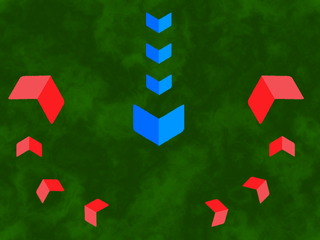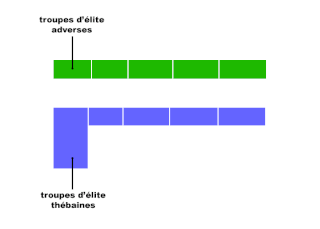
The Battle of Pharsalus was the decisive battle of Caesar's Civil War fought on 9 August 48 BC near Pharsalus in Central Greece. Julius Caesar and his allies formed up opposite the army of the Roman Republic under the command of Pompey. Pompey had the backing of a majority of Roman senators and his army significantly outnumbered the veteran Caesarian legions.

Gnaeus Pompeius Magnus, known in English as Pompey or Pompey the Great, was a general and statesman of the Roman Republic. He played a significant role in the transformation of Rome from republic to empire. Early in his career, he was a partisan and protégé of the Roman general and dictator Sulla; later, he became the political ally, and finally the enemy, of Julius Caesar.

The pincer movement, or double envelopment, is a military maneuver in which forces simultaneously attack both flanks (sides) of an enemy formation. This classic maneuver has been important throughout the history of warfare.
Titus Labienus was a high-ranking military officer in the late Roman Republic. He served as tribune of the Plebs in 63 BC. Although mostly remembered as one of Julius Caesar's best lieutenants in Gaul and mentioned frequently in the accounts of his military campaigns, Labienus chose to oppose him during the Civil War and was killed at Munda. He was the father of Quintus Labienus.

The Battle of Dyrrachium took place from April to late July 48 BC near the city of Dyrrachium, modern day Durrës in what is now Albania. It was fought between Gaius Julius Caesar and an army led by Gnaeus Pompey during Caesar's civil war.

The Battle of Munda, in southern Hispania Ulterior, was the final battle of Caesar's civil war against the leaders of the Optimates. With the military victory at Munda and the deaths of Titus Labienus and Gnaeus Pompeius, Caesar was politically able to return in triumph to Rome, and then govern as the elected Roman dictator. Subsequently, the assassination of Julius Caesar began the Republican decline that led to the Roman Empire, initiated with the reign of the emperor Augustus.

The Battle of Thapsus was a military engagement that took place on April 6, 46 BC near Thapsus. The forces of the Optimates, led by Quintus Caecilius Metellus Scipio, were defeated by the forces of Julius Caesar. It was followed shortly by the suicides of Scipio and his ally, Cato the Younger, the Numidian King Juba, and his Roman peer Marcus Petreius.
Publius Attius Varus was the Roman governor of Africa during the civil war between Julius Caesar and Pompey. He declared against Caesar, and initially fought Gaius Scribonius Curio, who was sent against him in 49 BC.

Caesar's civil war was a civil war during the late Roman Republic between two factions led by Gaius Julius Caesar and Gnaeus Pompeius Magnus (Pompey), respectively. The main cause of the war was political tensions relating to Caesar's place in the republic on his expected return to Rome on the expiration of his governorship in Gaul.

The oblique order is a military tactic whereby an attacking army focuses its forces to attack a single enemy flank. The force commander concentrates the majority of their strength on one flank and uses the remainder to fix the enemy line. This allows a commander with weaker or equal forces to achieve a local superiority in numbers. The commander can then try to defeat the enemy in detail. It has been used by numerous successful generals. Oblique order required disciplined troops able to execute complex maneuvers in varied circumstances.

The Battle of Ilerda took place in June 49 BC between the forces of Julius Caesar and the Spanish army of Pompey Magnus, led by his legates Lucius Afranius and Marcus Petreius. Unlike many of the other battles of the civil war, this was more a campaign of manoeuvre than actual fighting. It allowed Caesar to eliminate the threat of Pompey's forces in Hispania and face Pompey himself in Greece at the Battle of Pharsalus.

In military tactics, a flanking maneuver is a movement of an armed force around an enemy force's side, or flank, to achieve an advantageous position over it. Flanking is useful because a force's fighting strength is typically concentrated in its front, therefore, to circumvent an opposing force's front and attack its flank is to concentrate one's own offense in the area where the enemy is least able to concentrate defense.
The Battle of Nicopolis was fought in December 48 BC between the army of Pharnaces II of Pontus, the son of Mithdridates VI Eupator, and a Roman army led by Gnaeus Domitius Calvinus.
In military tactics, a flanking maneuver, or flanking manoeuvre, is an attack on the sides of an opposing force. If a flanking maneuver succeeds, the opposing force would be surrounded from two or more directions, which significantly reduces the maneuverability of the outflanked force and its ability to defend itself.

The Battle of the Abas was fought in 65 BC between the forces of the Roman Republic under Pompey Magnus and those of the Caucasian Albanian King Oroeses during the course of the Third Mithridatic War. The battle took place on a flat plain by the River Abas, after the Roman forces had only recently crossed over it from the other bank, and with much dense forest nearby. Pompey's victory neutralised the threat of the Albanians rejoining with their old ally Mithridates in his attempts to rekindle his lost war with Rome.
The Battle of Lauron was fought in 76 BC by a rebel force under the command of the renegade Roman general Quintus Sertorius and an army of Roman Republic under the command of the Roman general Gnaeus Pompeius Magnus. The battle was part of the Sertorian War and ended in victory for Sertorius and his rebels. The battle was recorded in detail by Frontinus in his Stratagems and by Plutarch in his Lives of Sertorius and Pompey.

The Ashanti Empire was an Akan empire and kingdom from 1701 to 1957, in modern-day Ghana. The military of the Ashanti Empire first came into formation around the 17th century AD in response to subjugation by the Denkyira Kingdom. It served as the main armed forces of the empire until it was dissolved when the Ashanti became a British crown colony in 1901. In 1701, King Osei Kofi Tutu I won Ashanti independence from Denkyira at the Battle of Feyiase and carried out an expansionist policy.
The Battle of Ascurum took place in 46 BC during Caesar’s Civil War and saw the defeat of a force under Pompey the Younger in battle against the Mauretanians.
Caesar's invasion of Macedonia occurred as part of Caesar's civil war, starting with his landing near Paeleste on the coast of Epirus, and continuing until he forced Pompey to flight after the Battle of Pharsalus.
The military tactics of Alexander the Great have been widely regarded as evidence that he was one of the greatest generals in history. During the Battle of Chaeronea, won against the Athenian and Theban armies, and the battles of Granicius and of Issus, won against the Achaemenid Persian army of Darius III, Alexander employed the so-called "hammer and anvil" tactic. However, in the Battle of Gaugamela, the Persians possessed an army vastly superior in numbers to the Macedonian army. This tactic of encirclement by rapid shock units was not very feasible. Alexander had to compose and decide on an innovative combat formation for the time; he arranged his units in levels; he pretended to want to encircle the enemy in order to better divide it and thus opened a breach in its defensive lines.















